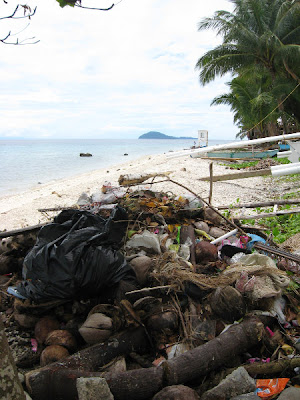Having
lived in Lungsodaan, Southern Leyte since 2005 I am wondering when
the local government of Padre Burgos is going to provide a properly managed rubbish collection and
environmentally friendly rubbish / waste dump.
The
nature of buying patterns in the Philippines, mainly buying
short-term / small quantities, generates huge quantities of (mainly)
plastic packaging. Huge population growth in recent years has
compounded the problem, not only through more people generating more
rubbish. With so many babies being born, huge numbers of largely
plastic baby-nappies (diapers) are consumed.
Most
of the rubbish generated by the local population in Southern Leyte
ends-up in the sea!
We
have all heard of the huge mass of rubbish collecting in the
north-central Pacific Ocean. Much of it has probably drifted there
from the Philippines!
http://ocean.si.edu/ocean-news/ocean-trash-plaguing-our-sea
OK. An exaggeration. But we have our own ecological disaster
under-way, right here in Sogod Bay and surrounds.
The
Padre Burgos Municipality has natural beauty in it's undersea Coral
Reefs and marine life. Scuba Divers and Whale-shark Tourists come
here from around the world. There presence greatly helps the local
economy by providing employment, fees from the MPA's, customers for
the restaurants & shops and spending on local produce.
But
this Tourism generated income is under threat!
The
fact is that most, if not all, of the rubbish from all of the towns
around Sogod Bay gets washed down the rivers and creeks onto the
beaches and Corals all along the coast of Lungsodaan, Santa Sofia,
Tankaan and even Limasawa Island.
Not
only does this rubbish get washed up on the beaches (we collect huge
amounts of rubbish from the beach every week) and lays along the
roads and streets throughout the community. The rubbish collects and
builds-up on the Coral Reefs through-out the bay
How
do our Foreign Tourists see our community?
Foreign
Tourists come from environmentally aware countries, where effective
rubbish collection is enforced and education about the damage caused
to the environment by careless disposal of our packaging is the norm.
They are, frankly, shocked that Filipinos care so little about their
Tropical Paradise.
Scuba
divers spend their valuable time and big-money come to the
Philippines and Southern Leyte to enjoy the natural underwater beauty
of the Coral Reefs and enjoy the marine life. What they find is
diminished marine life through over-fishing caused by gill-net
fishing, damaged Corals caused by the use of fish-traps (Bobos) and,
even more sadly, nets and rubbish strangling the Coral Reefs and
killing the marine animals (see our other Blog entries on these
problems).
What
are scuba shop operators to says to our guests when they surface,
after a 1- hour dive over the Sogod Bay Coral Reefs, with pockets
full of rubbish they have been compelled to salvage from the reefs?
We can only explain that the local community does not yet fully
understand the environmental damage they are causing and their
Governments have not yet taken the necessary action to provide
effective waste disposal.
But
these excuses cannot prevent these visitors from asking themselves...
"should I find a place to visit and scuba dive where I will not
be collecting more garbage than enjoyment"?
But
the locals residents cannot be really be blamed for this situation.
Local
residents have damaging buying practises because of their economic
situation. This can only be overcome through wealth creation; and
that is a different issue. But residents could be educated by
government about the issues of rubbish in the environment and this
could (and should) be done - with little cost involved.
But
if people were to stop dropping their rubbish in the streets, what
are they to do with what they pocket and take home to add to their
domestic rubbish? The real problem is there is no effective
domestic rubbish collection in the communities and no Province-wide
waste disposal system in place. Surely the Southern Leyte Government
needs to lead the way and provide an environmentally friendly system
of waste collection and disposal?
In
Summary...
Lungsodaan MPA
Rubbish collected in one week
No rubbish collection ??? They have been promising for 6 years
Santa Sofia MPA










































